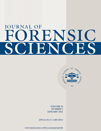Age Estimation in Indians Using Demirjian’s 8-teeth Method
Abstract
Abstract: Demirjian’s grading of tooth calcification is widely used to assess age of individuals with developing dentitions. However, its application on numerous populations has resulted in wide variations in age estimates and consequent suggestions for the method’s adaptation to the local sample. Conventionally, Demirjian’s method utilized seven mandibular teeth on the left side. A recent modification incorporated the third molar with a view to apply the method on a wider age-group. Moreover, the revised method developed regression formulas for assessing age. This paper tested the 8-teeth method using 547 Indians (348 females, 199 males) aged 7–25 years. Demirjian’s formulas resulted in inferior age prediction in Indians (9.2% misclassification at 99% confidence interval vs. 0% misclassification in the original study); therefore, India-specific regression formulas were developed, which gave better age estimates (mean absolute error, MAE = 0.87 years) than the original formulas (MAE = 1.29 years). This suggests that Demirjian’s 8-teeth method also needs adaptation prior to use in diverse populations.




